Dating your receivers - Page three
Number of pins on the valves
The style and shape of valves changed a fair bit over time. At first, valves looked a bit like light globes in that they had a round glass envelope, some pins on the bottom, usually four, an exhaust tip at the top and a bayonet cap at the bottom so that the valve could be 'screwed' into its socket. The valve type UX 201 comes to mind here and unfortunately I do not have one that I can take a picture of. A short time later the glass envelope was made larger and the pins were made longer so that the bayonet cap could be dispensed with. As per the UV 201, four pins was still the norm for the 1920's and most sets sported six or seven 201's or similar variants with each tuning stage in the receiver having its own tuning knob.

NOTE: This photo shows a group of UX 201's which were almost considered an industry standard. There were certainly other types of valve but the 201 was probably the most common by far. It is still quite easy to obtain them too though Australian made ones are extremly hard to find and when they are you can expect them to cost an arm and a leg.
Also note how the above valves still had that characteristic light globe shape. This was to change at the start of the 1930's when valves took on what I call 'hips' and the suffix 'G' was added to the type numbers. The shape is really hard to describe though whatever you want to call it, the shape remained the same for the next 15 years until the smaller 'GT' valves appeared. See the next photo for what I mean.

NOTE: The 280 on the right has the classic four pin base and the 5Y3G has five pins on octal bases. (The other three pins arn't required on this type of valve so they weren't included)
The year is 1937 and the Octal based valves come into existance yet the shape of the glass remains much the same as is indicated in the photos above. Note the 'key' on the central stub on the Octal base which makes sure that the evenly spaced pins find their way into the right holes in the socket. Australia was fortunate in a sense that our industry adopted the American valve base patterns instead of the European ones. Europe had so many different types of bases that there may as well have been a different one on each valve type. One such base type is pictured below and is a side-contact type, very popular in British sets but seldom used in this part of the world.
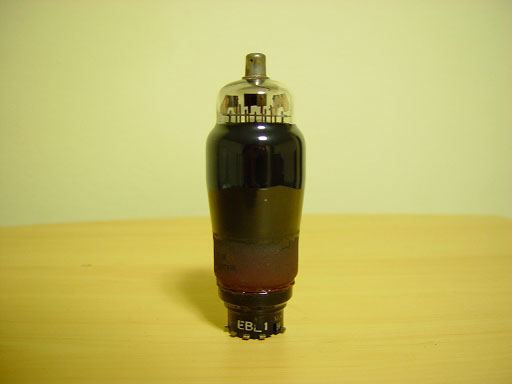
NOTE: This valve was extracted from a Kriesler 'Projectographic' receiver from 1938. Why they included this valve among a group of the more traditional four and six pin valves is something we may never find out. Even stranger is that this valve was British when the rest are made in Australia and that the receiver was also made here.
In 1949 the first baseless valves started to roll of production lines though Australia's industries were still recovering from a complete shutdown during World War 2, when manufacturing digressed from domestic consumables to making military hardware. Valves, condensers, radio cabinets and chassis gave way to tanks, guns, warships, planes all in the name of defeating Germany. Australia was also the sole allied supplier of telescopic lenses too! Australia did start using the baseless valves from about the middle of 1950 though it was a gradual progression. I own many four valve mantel models and a few of them boast a mix of Octal and baseless valves. From about 1952 onwards though, the baseless valves had taken over. They were simply a far better design and for the first time there was a standard base pattern throughout the world.
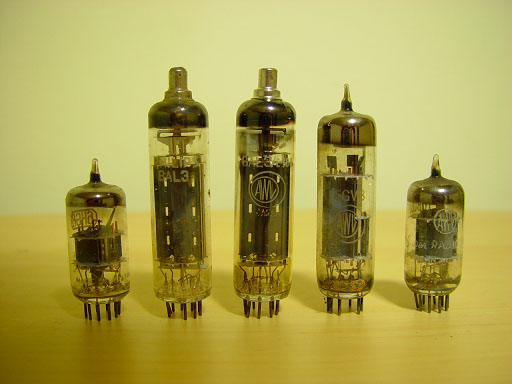
NOTE: All these valves are of the baseless type. They were quite strong too and could take a bump, even being dropped on hard floors and with the pins being directly on the valve instead of connected with delicate wire proved another strong point. These valves remained in force right up until the introduction of transistorised receivers in the 1960's.
So it is possible to date most receivers to +-5 years by using the valve lineup, though it has to be taken into consideration that the valve lineup has either been modified or completly replaced at some stage. I have a 1933 console radio, probably a Weldon because it has a Weldon dial, and the 80/47 recifier and power valve lineup has been replaced with 5Y3G and 6V6G respectively. These latter valves were not made in the early 1930's that is for sure! The other three valves in this brandless set are of the correct type though and along with the Weldon dial, this gives a reasonable indication as to the decade the receiver was made in.
Serial number on the licence transfer
"Did you just say licence?", I hear some people asking. That is quite correct. Back in the first days of radio there was no advertising. The handful (six or so) stations in Australia earned their revenues from a carve-up of licence fees collected from listeners. This system led to the inception of what we now know as the Australian Broadcasting Corporation, EG: Channel 2 Television and I think around four different radio networks, they being (only Sydney callsigns listed here) Radio National (2FC), ABC AM (2BL), Triple J (2JJJ), ABC Classic FM (2ABC, 92.9).
Because the ABC developed a marketing department, today known as the ABC Shops, and also from a massive injection of taxpayer funding, the former A Class radio stations no longer required licence fees as a source of revenue and the listener licencing system became outdated. On the 1st of September 1974 radio and television licences were abolished. For the first time you could own and listen to a radio without having to pay for the privilege.
As a reminder that people were required to possess a licence and to remind them about existing patents applying to radio broadcasting there was a special transfer on the back of every single commercially manufactured radio from 1934 right up until abolition in 1974. Over time the appearance changed slightly a few times, as did the material the labels were made from.
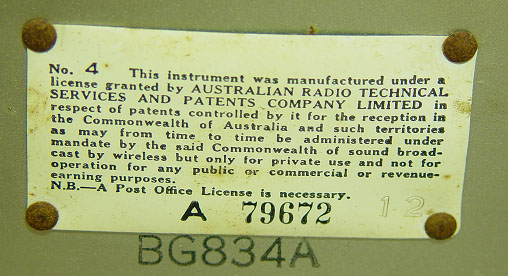
NOTE: This is the first of the licence transfers that would adorn Australian radios for the next forty years.
Notice the prefix letter "A", which came to mean that the set was made in 1934. A full table showing letters to years of manufacture follows below.
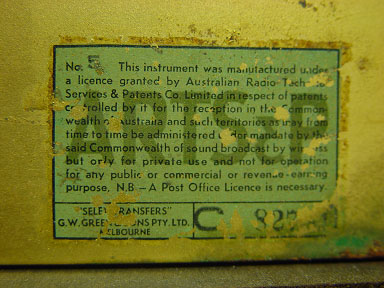
NOTE: From 1935, onwards, the labels were similar to the old car registration labels. They were soaked in water for a moment and then pressed onto the surface and left to dry. This method was cheap and reasonably quick to manufacture and apply to radio chassis'.
This licence transfer is from a 1936 Weldon console receiver. This date was determined from the prefix letter "C" in the serial number. When the tranfers came out, the spelling of the word "licence" was also corrected.
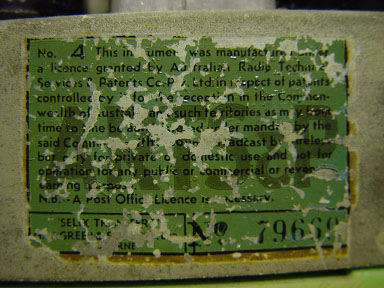
NOTE: Gone are the days of the prefix letters. After World War II it was deemed that the year of manufacture could be obtained easily from model numbers, a feature not present in some early sets. Unfortunately it is hard to get hold of a receiver with a licence transfer fully intact. These things are wafer thin and over the years they go brittle and peel off like sunburnt skin.
The colour changes from blue to green. The last of the blue labels was also the swansong for the prefix letter on the serial numbers. It is my understanding that the letters G, H and T were used during and after World War II for a short time before the letter disappeared altogether. G indicated 1940 and 1941, H was used on a few sets made during wartime but before manufacturing stopped to aid the war effort. T was used to indicate a 'post-war' receiver though I am yet to see the letters H and T on any receiver.
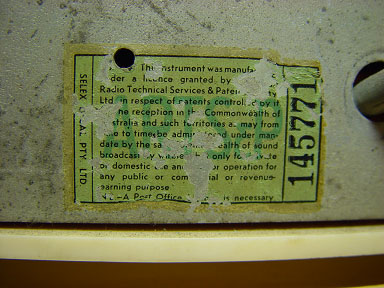
NOTE: In the 1950's the labels got smaller and started to include the words "and Television" to describe the patent information.
The above picture is from a 1947 AWA Radiolette, a popular receiver in brown or white though I own a green one so there were a few coloured ones out there too. This model started out with the larger label but the 1950 variant sported the smaller one. The labels got smaller simply because the radios were going much the same way. The 1950's was the decade of the four valve mantel midgets and space was at a premium in most of them. As such, chassis' were rather shallow. In a succesful attempt at economising, manufacturers put five valve versions of these mantel models in their consoles and radiogram models, creating an insanely weird look inside the rear of the cabinets though by this stage it was hard to tell as receivers were generally equipped with back panels, usually made of masonite, making the economising attempts hard to discover.
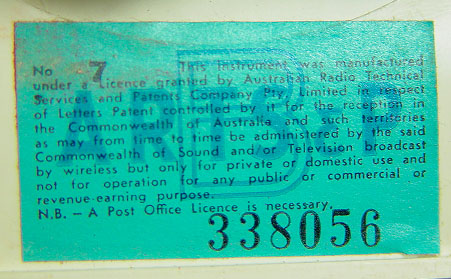
NOTE: The 1960's brought transistorisation and a timely end to the valve era.
In the 1960's there were many changes. Licence labels were made of cardboard and simply glued to the inside of a cabinet which was most likely made of some kind of thermoplastic material instead of the more durable and attractive bakelite. Transistorisation also became commonplace which meant that radios no longer contained the dangerous voltages of the valve era, except the mains powered ones of course!

Sign In

Vintage Radio and Television is proudly brought to you by an era where things were built with pride and made to last.
DISCLAIMER: Valve radios and televisions contain voltages that can deliver lethal shocks. You should not attempt to work on a valve radio or other electrical appliances unless you know exactly what you are doing and have gained some experience with electronics and working around high voltages. The owner, administrators and staff of Vintage Radio & Television will accept no liability for any damage, injury or loss of life that comes as a result of your use or mis-use of information on this website. Please read our Safety Warning before using this website.
WARNING: Under no circumstances should you ever apply power to a vintage radio, television or other electrical appliance you have acquired without first having it checked and serviced by an experienced person. Also, at no time should any appliance be connected to an electricity supply if the power cord is damaged. If in doubt, do not apply power.
Shintara - Keepin' It Real · VileSilencer - Maintain The Rage
